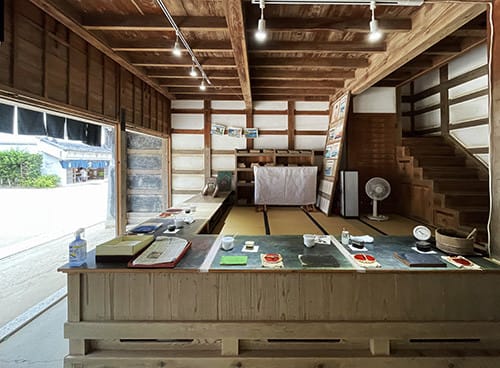

出版という仕事にわたしは人生時間をほぼ費やしてきました。どうしてなのか?小学校に上がるかどうかのころに日本のテレビ放送が始まって、力道山のプロレスが札幌大通公園の街頭テレビで放送し始めた。父に連れられてそれを1−2度は見たのだろうか。映像の迫力とその臨場感に熱狂した父はさっそく2軒となりの電気屋さんに頼んですぐにテレビを購入した。以来、映像文化のたぶん最初期受容世代としてメディアというものに惑溺してきた。また街中の小学校だったので、ときどきNHK地方局の「子ども参加番組」に出演することもあった。メディアというものが身近な存在であって将来そういう仕事をと夢想していたのだろうか。
その後、結局メディアというのは経済的に広告事業の一環であることが腑に落ちて、広告業でその成立の根源的な部分について学習し経験を積んだ。結果として「カラー写真がたっぷり表現された」地域メディアというものを創造する事業に邁進してきた。そういう自分の体験と照らし合わせたとき、日本史の中でこの江戸期の「浮世絵」がもたらした大衆芸術の世界はまぶしい民族的先行事例として自分の中で光を放っていた。これは想像するしかないけれど、江戸期の人びとにとって手頃な価格で入手できたカラー印刷物の即物性は無上の存在だっただろう。浮世絵の醸し出す想像力世界に触れることで、全国旅行ブームというのが江戸期を通じて盛んになっていった事実。また見世物芝居のスターたちがブロマイドのように表現された。さらに女性美というものがはじめて「メディア化」していった。結果として人間の本然を刺激する自由な大衆の娯楽が驚異的な盛り上がりを見せた。江戸期の浮世絵は名所・役者絵・美人画というジャンルを開拓したけれど、わたしは地域の「いい家」という空間の奥行きを表現したいと祈念している。「いごこちの見える化」というテーマか。


「房総のむら」でそれが町家の一典型として建築的に明示されていたことは思ってもいなかった奇跡的な遭遇。「そうか具体的にはこういうしつらいの空間から浮世絵は生産されていったのか」という驚異の体験なのです。ちょうど自分がテレビ世代として映像文化に惑溺したように、江戸期の人びとは浮世絵からのわかりやすいカルチャーショックに惑溺していたのだと思う。日本社会の大衆文化にとってこうした変化はまさに革命だったと思える。
その基礎になったのが、絵師と彫り師・刷り師という技術者たち。絵師については芸術家としての名声がはるかな後代まで名を残すけれど、しかしそのベースは彫り師・刷り師の技術開発がすべての根源だっただろう。基盤は江戸期の大衆芸術を支えた映像表現の知の結晶がもたらしたもの。その努力の痕跡を見て、はるかに触発され続けている自分がいる。
English version⬇
Ukiyo-e and the Popular Media Revolution - 3: Edo Period, Boso Machiya - 12
For those of us who experienced the postwar TV cultural revolution, the rise of popular color painting and publishing in the Edo period seems to us to be a dazzling trace of our ancestors. ...
I have spent most of my life in the publishing business. Why? When I was about to enter elementary school, Japanese TV broadcasting started and Rikidozan's wrestling began to be broadcast on street TV in Sapporo Odori Park. My father took me to see it once or twice. My father was so enthralled by the power and realism of the images that he immediately asked an electronics store two doors down to buy a TV set. Since then, as one of the first generations to be exposed to the visual culture, I have been absorbed in the media. Since it was an elementary school in the city, I sometimes appeared in "children's participation programs" on NHK's local station. Perhaps I was so familiar with the media that I dreamed of working in such a field in the future.
Later, it became clear to me that the media was economically part of the advertising business, and I learned and gained experience in the fundamental aspects of its formation in the advertising business. As a result, I have been working hard to create local media that are "richly illustrated with color photographs. In light of my own experience, the world of popular art brought about by ukiyo-e in the Edo period shone in my mind as a dazzling national precedent in Japanese history. One can only imagine what the immediacy of affordable color prints must have been like for the people of the Edo period. The fact is that the nationwide travel boom that was triggered by exposure to the imaginative world of ukiyo-e prints flourished throughout the Edo period. The stars of freak shows were represented in the form of bromides. In addition, female beauty was "mediatized" for the first time. As a result, the free entertainment of the masses, which stimulated human nature, enjoyed a phenomenal rise. Ukiyo-e of the Edo period pioneered the genres of famous places, portrayals of actors, and paintings of beautiful women, and I wish to express the depth of the space of "good houses" in the region. The theme of "visualization of comfort"?
It was a miraculous encounter that I had never expected to see it manifested architecturally as a typical "machiya" (townhouse) in the village of Boso. It was a marvelous experience for me to realize that Ukiyo-e was produced from this kind of space. Just as I was dazzled by visual culture as a member of the television generation, I believe that the people of the Edo period were dazzled by the easy-to-understand culture shock from Ukiyo-e. I believe that these changes were truly revolutionary for the popular culture of Japanese society.
The basis for this change was the painter and the engraver/printer. Although painters will remain famous as artists until far into the future, I strongly believe that the development of engraving and printing techniques was the basis for all of these changes. The foundation for this was the crystallization of the knowledge of visual expression that supported popular art in the Edo period. Seeing the traces of these efforts, I find myself continually inspired.










